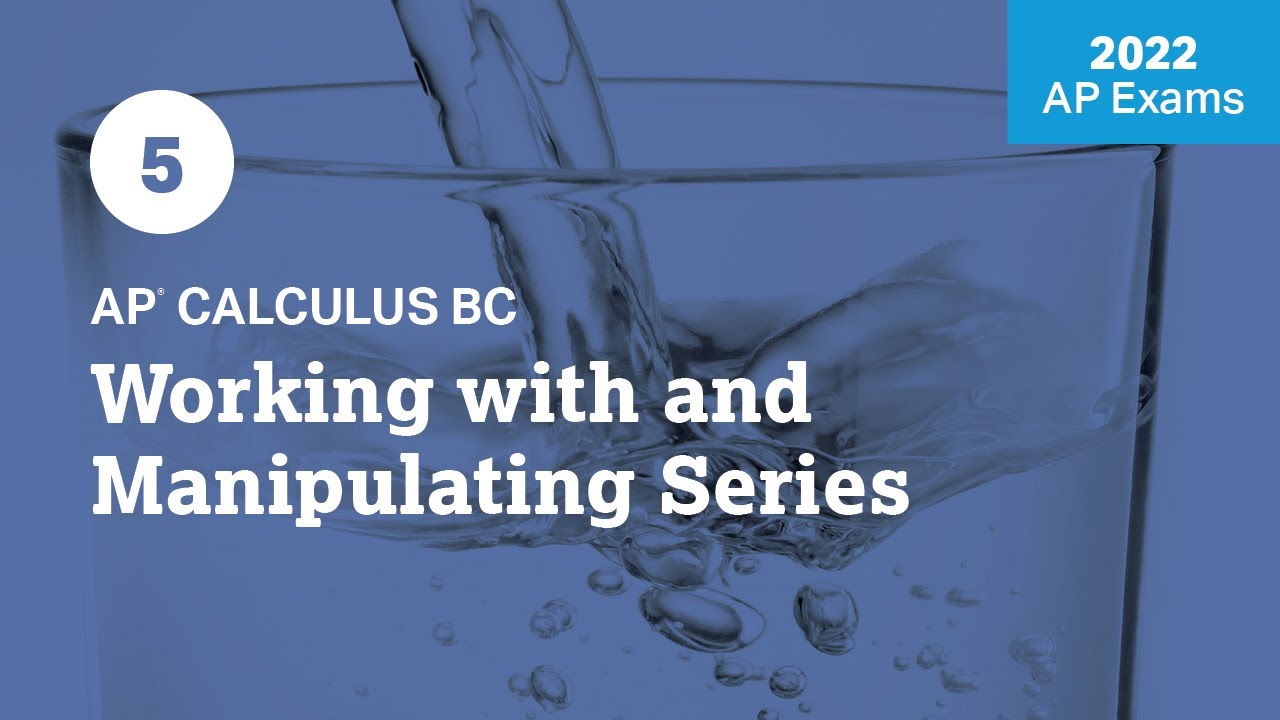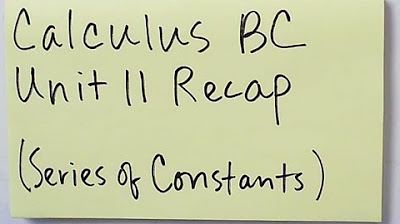2022 Live Review 4 | AP Calculus BC | Convergent and Divergent Series
TLDRIn this engaging AP Calculus BC review session, hosts Tony and Brian delve into convergence tests, exploring various rules and tests that students must master for the AP exam. They discuss the importance of understanding not only the convergence and divergence of series but also the specific conditions and special comments associated with each test. The session is filled with practical examples, highlighting the need to recognize the form of a series to select the appropriate test and emphasizing the significance of checking conditions before applying theorems. The hosts also address common confusion points, such as the difference between absolute and conditional convergence, and provide strategies for tackling challenging problems on the exam.
Takeaways
- 📚 The importance of understanding convergence tests for AP Calculus BC, including various rules and tests to keep in mind.
- 👋 An introduction to the hosts, Tony and Brian, and their roles in the AP Live Daily Review series.
- 🎯 The focus on convergence tests such as the Ratio Test, Integral Test, and Alternating Series Test, and their respective conditions for application.
- 📝 The suggestion to use note cards or electronic flashcards for studying convergence tests and their conditions.
- 📈 Emphasis on the need to check the conditions of theorems and convergence tests before application, as overlooked conditions can lead to incorrect conclusions.
- 🔍 Guidance on identifying the correct convergence test to use by recognizing the form of the series and applying the appropriate test based on the conditions.
- 🌟 The highlight of the Limit Comparison Test (LCT) as a 'don't sweat the small stuff' test, focusing on the most dominant terms in the numerator and denominator.
- 📊 Explanation of the n-term test as a quick eliminator for series convergence, which checks if the terms approach zero.
- 🔄 The concept of absolute versus conditional convergence, and the significance of determining whether a series would converge without the alternating part.
- 🚀 Tips for tackling multiple-choice questions on the AP exam, such as looking for the role of 'n' in the problem to identify if it's a geometric or p-series.
- 💪 Encouragement for students to persevere and appreciate the hard work they put into preparing for the AP exam, as these efforts will benefit them in college and future careers.
Q & A
What is the main topic of discussion in the video?
-The main topic of discussion in the video is convergence tests for infinite series in AP Calculus BC, including various rules, tests, and conditions related to them.
Who are the hosts of the AP Live Daily Review session?
-The hosts of the AP Live Daily Review session are Tony Record and Brian Passwater.
What type of series is mentioned at the beginning of the video as an example of a series that may not have been covered in detail during the week?
-The series mentioned at the beginning of the video is the ratio test series.
What is the significance of the limit of the nth term in determining the convergence of a series?
-The limit of the nth term is significant because it helps determine if the series converges or diverges. If the limit of the nth term approaches zero, the series may converge; if it does not approach zero, the series definitely diverges.
What is the condition for a p-series to converge?
-A p-series converges if the exponent p is greater than 1.
What is the integral test and what are its conditions?
-The integral test is a convergence test for comparing the convergence of an infinite series to the definite integral of a related function. The conditions for the integral test are that the function must be positive, continuous, and decreasing.
What is the significance of the alternating series test and its conditions?
-The alternating series test is significant because it provides a way to determine the convergence of a series that alternates in sign. The conditions for the alternating series test are that the terms of the series must approach zero and the sequence of terms must be decreasing.
What is the limit comparison test and how is it used?
-The limit comparison test is a method for determining the convergence of two series by comparing their limits as n approaches infinity. If two series have the same limit (other than zero), they either both converge or both diverge.
What is the importance of understanding the conditions for convergence tests in AP Calculus BC?
-Understanding the conditions for convergence tests is crucial because it allows students to correctly identify which test to use for a given series and to accurately determine whether the series converges or diverges. This understanding is essential for success on the AP Calculus BC exam.
What advice is given to students for studying the convergence tests?
-Students are advised to use note cards, electronic flashcards, or other study aids to memorize the convergence tests, their conditions, and conclusions. They are also encouraged to review the materials provided in their AP classroom and to watch daily videos for additional examples and explanations.
Outlines
📚 Introduction to AP Calculus BC and Convergence Tests
The video begins with a lively introduction to the Advanced Placement (AP) Calculus BC course, highlighting the importance of understanding convergence tests. The hosts, Tony and Brian, set a friendly and humorous tone, acknowledging the end of the first week of classes. They emphasize the significance of mastering various convergence tests, such as the Ratio Test, Alternating Series Test, and Limit Comparison Test, which are crucial for success in the AP Calculus BC exam. The video aims to clarify these concepts and provide strategies for remembering them, suggesting the use of flashcards and textbooks for study.
📈 Understanding the Ratio Test and Its Application
This segment delves into the specifics of the Ratio Test, a method for determining the convergence or divergence of a series. The hosts explain the process of applying the test, which involves taking the limit of the ratio of consecutive terms and evaluating whether this limit is less than, equal to, or greater than one. They clarify that a series converges if the limit is less than one and diverges if it is greater than one. The hosts also discuss the importance of considering the conditions and special comments associated with each test, as well as the significance of the test's name and form.
📊 Conditions for Applying the Integral Test
The discussion shifts to the Integral Test, with the hosts outlining the necessary conditions for its application: the function must be positive, continuous, and decreasing. They explain that while the function's terms are discrete, the function itself should be continuous to apply this test. The hosts also address common misconceptions about the test, such as the requirement for differentiability, which is not a condition for the Integral Test. They stress the importance of understanding these conditions to avoid confusion and ensure accurate application of the test.
🔍 Identifying the Correct Convergence Test
The hosts emphasize the importance of recognizing the form of a series to determine the appropriate convergence test. They note that while problems may not explicitly state which test to use, understanding the series' form is crucial. They highlight two essential conditions for series convergence: the terms must approach zero, and they must do so quickly enough. The hosts also discuss the challenge of memorizing the conditions and conclusions of each test, suggesting that understanding the underlying concepts can make these easier to remember.
📝 Applying the Alternating Series Test
The video continues with an exploration of the Alternating Series Test, focusing on its conditions for use. The hosts clarify that for an alternating series to converge, the terms must decrease in size and approach zero. They also discuss the concept of conditional versus absolute convergence, explaining that an alternating series can converge even if the terms do not approach zero quickly enough, due to the alternating nature of the series. The hosts provide a nuanced explanation of how the Alternating Series Test can be applied and the implications of its results.
🤔 N-Term Test and Series Convergence
The hosts discuss the N-Term Test, a quick method to determine if a series diverges. They explain that if the terms of the series do not approach zero as n approaches infinity, the series diverges. The N-Term Test cannot be used to show convergence, only to eliminate the possibility. The hosts also address the limitations of the N-Term Test, noting that while it can show divergence, other tests may be needed to confirm convergence.
📊 Limit Comparison Test and Dominant Terms
The Limit Comparison Test (LCT) is the focus of this section, with the hosts explaining its simplicity and effectiveness. They describe the LCT as a 'don't sweat the small stuff' test, emphasizing that the most dominant terms in the numerator and denominator determine the series' behavior. The hosts illustrate how to apply the LCT by comparing the series to a simpler series with similar dominant terms, using this comparison to predict the series' convergence or divergence.
📈 Series Convergence: P-Series and Geometric Series
The hosts tackle the P-Series and Geometric Series tests, providing clear guidelines for their application. They explain that for a P-Series, the exponent (p) must be greater than one for the series to converge, while for a Geometric Series, the common ratio (r) must have an absolute value less than one. The hosts also offer strategies for identifying the correct test based on the role of 'n' in the series expression, such as 'n' being in the base or the exponent, and how this informs the choice of test.
🔢 Partial Sums and Convergence of Series
The concept of partial sums and their relationship to series convergence is explored in this segment. The hosts clarify that the convergence of a series is equivalent to the limit of its partial sums. They discuss the implications of the limit of partial sums for the convergence of a series, noting that if the limit is a finite value, the series converges to that value. The hosts also address misconceptions about the N-Term Test in relation to partial sums, emphasizing that the test applies to individual terms, not sums.
🤓 Conditional Convergence and Series Analysis
The video concludes with a deeper examination of conditional convergence, contrasting it with absolute convergence. The hosts use a flow chart to illustrate the process of determining whether a series converges conditionally or absolutely. They explain that an alternating series can converge without the alternating part, and the presence of the alternating component does not necessarily push the series into convergence. The hosts encourage students to understand the root concepts behind these types of convergence to solve problems effectively.
🙌 Final Thoughts and Encouragement for AP Students
In the closing remarks, the hosts express their appreciation for the students' hard work and dedication. They highlight the importance of checking conditions and understanding the nuances of convergence tests. The hosts remind students that their efforts will pay off not only in their AP scores but also in their future academic and professional endeavors. They encourage students to persevere and challenge themselves, valuing the habits and skills developed through the study of AP Calculus BC.
Mindmap
Keywords
💡Convergence Tests
💡AP Calculus BC
💡Series
💡p-Series Test
💡Geometric Series
💡Alternating Series Test
💡Limit Comparison Test
💡Absolute Convergence
💡Conditional Convergence
💡nth Term Test
Highlights
The session focuses on convergence tests for AP Calculus BC students, providing an in-depth review of various tests and rules.
The importance of understanding not only the convergence and divergence information but also the conditions and special comments associated with each test is emphasized.
Students are encouraged to use note cards or electronic flashcards to study the convergence tests for better retention.
The session discusses the significance of the limit comparison test, highlighting its robustness and the fact that it is tested frequently.
The ratio test is explained in detail, including how to set it up and interpret the results, which is crucial for series convergence determination.
The integral test is discussed, with emphasis on its conditions and how it differs from other tests in terms of application.
The alternating series test is covered, explaining the conditions for its application and how it differs from other convergence tests.
The n-term test is highlighted as a quick eliminator for series convergence, with its limitations and proper application discussed.
The session emphasizes the importance of checking conditions before applying theorems, which is a key mathematical practice.
The concept of absolute versus conditional convergence is introduced, providing insights into the underlying principles of series convergence.
The session provides a strategy for determining which convergence test to use by looking for the role of 'n' in the problem.
The geometric series and its convergence criteria are discussed, with practical tips for quick determination of convergence.
The session concludes with a reminder of the importance of hard work and perseverance, not just for AP scores but for future academic and career success.
The p-series test is explained, with the importance of the value of 'p' in determining the convergence of a series highlighted.
The session introduces a method for students to identify the type of series (geometric or p-series) by examining the role of 'n' in the problem.
Transcripts
Browse More Related Video

Monday Night Calculus: Strategy for testing series

1 | MCQ | Practice Sessions | AP Calculus BC

2021 Live Review 6 | AP Calculus BC | Everything You Need to Know About Convergence Tests

2022 Live Review 5 | AP Calculus BC | Working with and Manipulating Series

Calculus BC Unit 11 Recap

5 | MCQ | Practice Sessions | AP Calculus BC
5.0 / 5 (0 votes)
Thanks for rating: